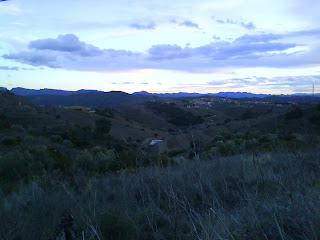Gratallops is a Catalan village at the heart of Priorat. L'Ermita by Alvaro Palacios, Clos Mogador by Rene Barbier and Clos de L'Obac by Charles Pestrana are some of the heavy hitting vintages that have made the likes of Robert Parker do bare knuckle push-ups in the middle of the night from sheer anticipation. Priorat is a beautiful place with steep terraced vineyards that fold and buckle up to this mountain-top town. Gratallops is a bit sleepy in the wintertime but what are you going to do? Drink wine and invade the vines of these world-class winemakers is what I did last February. [...]
At the risk of generalizing, Priorat is Mediterranean wine. The main grapes at hand are grenache and carignan (granatxa and carinena, in the local tongue). At it's higher end, Priorat goes toe to toe with the giants of Chateauneuf du Pape. Provancal herb. Oregano. Laurel. Aniseed. Exceptional minerality. The soil in Priorat is called llicorella, a bluish slate that transmits distinct flavours into thirsty root systems. Here's a visual of the rock, built in this instance into an impenetrable llicorella wall. Versatile.
I went to Priorat last February and toured Costers de Siurana, which is run by the Pestana family. The 2004 Clos de L'Obac is a dry red built from grenache (35%), Cabernet Sauvignon (35%), syrah (10%), merlot (10%) and carignan (10%). I tasted the 2004. The tour guide, who also made the wine, told me it was their flagship, shrugging like it was no big thing, pointing distant parcels of land like a HomeDepot guy pointing at faucets. Very humble, unassuming people. I'm looking forward to this wine. I've matched it with Beef Wellington.
Beef Wellington (adapted from Gordon Ramsay's Sunday Lunch)
What you'll need:
- 400 grams of mushrooms, roughly chopped
- 750 grams of beef fillet.
- 2 tablespoons of mustard
- 8 slices of prosciutto
- 500 grams of ready-made puff pastry
- two egg yolks, beaten
- olive oil for searing
- salt and pepper
- flour for dusting
1. Put some mushrooms into a food processor with salt and pepper and pulse to a rough paste. Scrape paste onto a pan and cook over high heat for 10 minutes to cook out the moisture. No need for oil. Spread on a plate to cool.
2. Heat frying pan and add a little olive oil. Season and sear beef for 30 seconds on each side. Remove from the pan and leave to cool. Once cool, brush all over with mustard.
3. Lay a sheet of plastic wrap on your work surface and arrange Prosciutto on it in overlapping rows. Spread mushroom paste over the Prosciutto and place seared beef in the middle. Keeping a tight hold of the plastic wrap from the edge, neatly roll Prosciutto and mushrooms around the beef fillet to form a tight barrel shape. Twist the ends of the plastic wrap to secure. Chill for 20 minutes to allow beef to set and take shape.
4. Roll out puff pastry on a floured surface. (I bought the pastry in the supermarket pre-rolled). Remove the plastic wrap from the beef and lay it in the centre. Brush the surrounding pastry with egg yolk. Fold ends over, then wrap the pastry around the beef, cutting off any excess. Turn over, so the seam is underneath, and place on a baking sheet. Brush all over the pastry with egg and chill for about 15 minutes to let the pastry rest. Heat the oven to 400 degrees F. (I screwed up here, confusing F and C, used in Ramsay's book - stupidity).
5. Lightly score the pastry at 1 cm. intervals and gaze again with beaten egg yolk. Bake for 20 minutes, then lower the over to 380 degrees F and cook for another 15 minutes. Allow to rest for ten to fifteen minutes before slicing a serving with sides (I went with oven roasted vegetables by Jamie Oliver - http://www.jamieoliver.com/recipes/vegetarian-recipes/roast-vegetable-mega-mix).
Check out Gordon Ramsay getting his beef wellington on...
This is a shot of the sweet carnivorous loaf I produced.
How did the 2004 Clos de L'Obac Match Up?
For a wine of such stark minerality, the Clos de L'Obac is very smooth. The palate texture is what got me. I jotted down in my notes..."it has the full silkiness of a fine California Cab while remaining a dry herb and earth old world wine." It's an unlikely (almost contradictory) sensation spectrum: thick richness with a refreshing purity. Each sip was a cleansing. There wasn't a trace of alcohol on the nose yet it had a powerful presence. The wine could stand up to and compliment strong game dishes but could also be sipped on its own. I got aniseed, earth, many complex layers of mineral tyical to Priorat's terroir. But to be honest, I'm stretching here. That's one of the things I find about wine - it's pretty simple to determine what makes a wine bad but difficult to say what makes it good, and even more challenging to determine what make a wine exceptional. I think this is an exceptional wine.
Clos de L'Obac worked very well with Beef Wellington. I would, however, like to try it with roasted leg of lamb or oxtail stew. Something typical to the Priorat region.




No comments:
Post a Comment